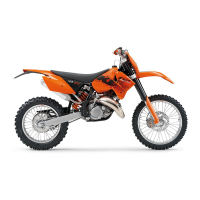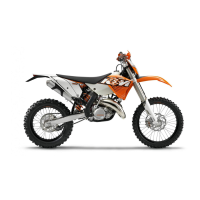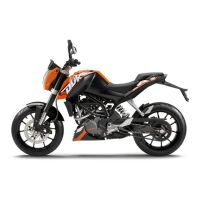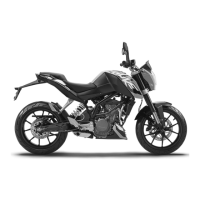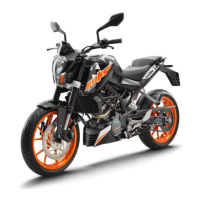11 TUNING THE CHASSIS 44
11.8 Checking the riding sag of the shock absorber
400990-10
–
Measure distance
of the unloaded rear wheel. ( p. 43)
– With another person holding the motorcycle, the rider, wearing full protective cloth-
ing, sits on the seat in a normal sitting position (feet on footrests) and bounces up
and down a few times.
The rear wheel suspension levels out.
– Another person now measures the distance between the rear axle and a fixed point.
–
Note down the value as dimension
.
Info
The riding sag is the difference between measurements
and
.
– Check the riding sag.
Guideline
(All 125/200 models)
Riding sag 100… 110 mm (3.94… 4.33 in)
(All 250/300 models)
Riding sag 105… 115 mm (4.13… 4.53 in)
» If the riding sag differs from the specified measurement:
– Adjust the riding sag. ( p. 45)
11.9 Adjusting the spring preload of the shock absorber
Caution
Danger of accidents Disassembly of pressurized parts can lead to injury.
– The shock absorber is filled with high density nitrogen. Adhere to the description provided. (Your authorized KTM workshop
will be glad to help.)
Info
Before changing the spring preload, make a note of the present setting, e.g., by measuring the length of the spring.
Preparatory work
– Raise the motorcycle with the lift stand. ( p. 52)
– Remove the shock absorber. ( p. 65)
– After removing the shock absorber, clean it thoroughly.
401026-10
Main work
–
Loosen screw
.
–
Turn adjusting ring
until the spring is no longer under tension.
Hook wrench (T106S)
– Measure the overall spring length while the spring is not under tension.
–
Tighten the spring by turning adjusting ring
to measurement
.
Guideline
(All 125/200 models)
Spring preload
Comfort 10 mm (0.39 in)
Standard 10 mm (0.39 in)
Sport 10 mm (0.39 in)
(All 250/300 models)
Spring preload
Comfort 7 mm (0.28 in)
Standard 7 mm (0.28 in)
Sport 7 mm (0.28 in)

